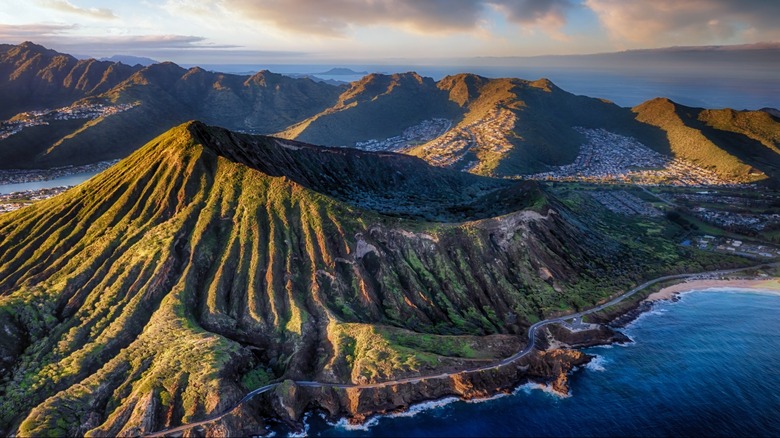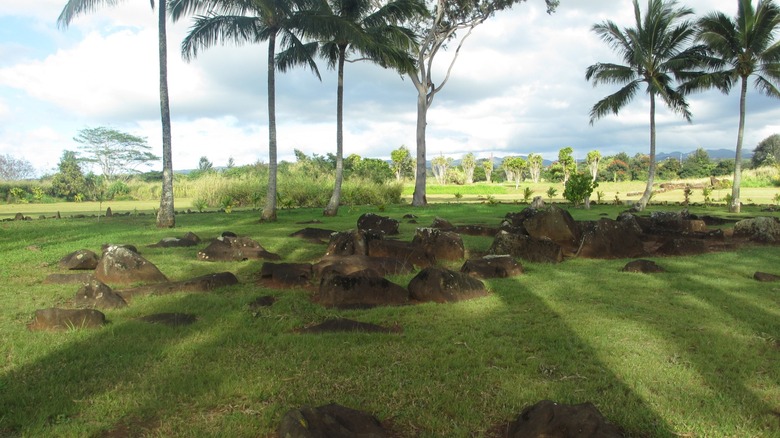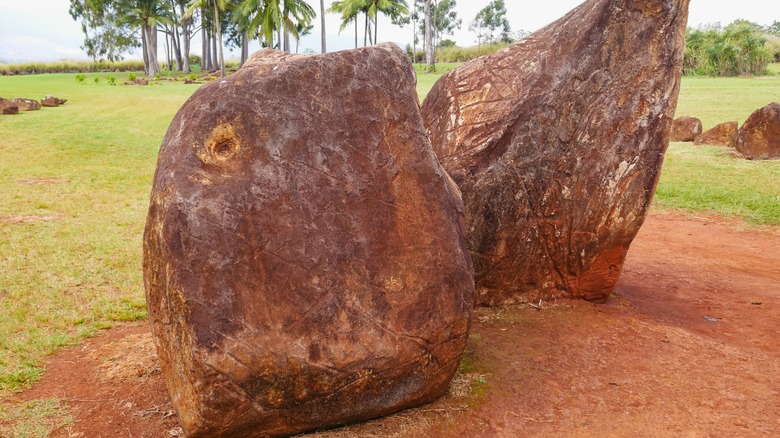One Of Hawaii's Most Important Ancient Sites Is A Sacred Spot Of Striking Views And Spiritual Energy
The Hawaiian Islands were once known for their simplicity, their stretches of greenery broken up only by scatterings of volcanic rock or towering sea cliffs. Today, commerce and neighborhoods cut through once-open fields where ancient peoples settled and made use of the land and its resources. Often, that meant unknowingly (or knowingly) desecrating the spiritual energy believed to course through the island's veins, flowing from sacred sites like the Kukaniloko Birthing Stones of Oahu.
Despite their proximity to civilization, the birthing stones remain safe from the modernization of the islands. Though no longer used, they continue to carry the legacy of the Hawaiian chiefs welcomed into the world on the sacred site. Nestled near Wahiawa, just south of the Dole Plantation and its massive pineapple garden maze, mankind may have very likely encroached on the stones if not for their protection by the Daughters of Hawaii since 1925. To further guarantee the sanctity of the site and surrounding lands, the Hawaiian Civic Club of Wahiawa took over the preservation of them in 1960. Within 13 years, the stones were added to the National Register of Historic Places.
Today, the stones remain protected, which makes visiting them a bit difficult. As of January 2022, public access was removed, and the Office of Hawaiian Affairs has remained diligent in preserving the sacred site and the five acres of land surrounding it. However, that doesn't mean seeing the stones can't still land on a list of the best experiences available on Oahu.
Viewing the Kukaniloko Birthing Stones
Though there is no public access to the birthing stones, they're still visible to curious travelers. You won't be able to explore the lands or get a very good picture of the entire site, but there is a view from the road. You'll want to head to the intersection of Whitmore Avenue and Route 80 (Kamehameha Highway), just beyond the Ali'i Agriculture Farms. There's no official parking area, so you'll need to pull over quickly, grab a few photos, and be on your way.
Route 80 is a busy road that starts near Pearl City and ends by one of the nation's best sandbars, Kaneohe Bay. If you're already stopping at Ali'i Agriculture Farms for its fishing farms, you may be able to make the quick 9-minute walk. There is a sidewalk on the north side of Whitmore, but to get there without jaywalking, you'll need to start deeper in Whitmore Village, possibly at Whitmore Community Park, as there is no pedestrian crosswalk until the birthing stones or Ihi'ihi Avenue and Whitmore. The walk from Whitmore Community Park is still a manageable 1.1 miles, which is worth it to see a portion of the sacred grounds.
Like any sacred site on the Hawaiian Islands, if you decide to see the stones, be respectful of any barriers in place. Not only is it the right thing to do, but you also don't want to mess around with the heavy spiritual energy the islands are known for.
History of the Kukaniloko Birthing Stones
It may sound like a lot of effort to see a bunch of scattered stones, but like so many things in Hawaii, there's a fascinating story behind them worth knowing. Deeply rooted in ancient Hawaiian lore, the Kukaniloko Birthing Stones served as a sacred site where new chiefs were ushered into the world. Whenever a new chief was ready to be born, the mother would give birth at the sacred stones, surrounded by 36 Hawaiian nobles (or ali'i), sitting on two rows of 18 rocks. An additional 48 ali'i would actually participate in the birth, assisting the mother in ensuring the new chief survived the process.
While important to the royal lineages of the islands, the stones are also believed to be linked to local astronomy. More specifically, the site aligned with archaeoastronomy, or astronomy using physical objects. Celestial bodies are deeply rooted in Hawaiian culture, and representatives of the University of Hawaiian Institute for Astronomy noted markings on the stones that are thought to have once tracked celestial objects. Researcher and author Martha Noyes explored the possibilities of these markings, eventually determining via astronomy software that the celestial bodies were stars.
Though Kukaniloko may no longer be an active birthing site, local Hawaiians continue to treat the grounds as sacred. In 2022, Hawaiian Civic Club of Wahiawa member Tom Lenchanko developed a plan to reforest the 10 acres surrounding the birthing stones to preserve the site through active watershed management.


